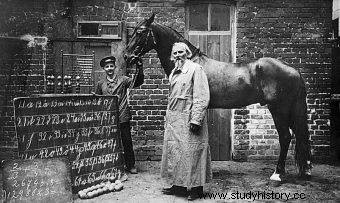The story of the Wise Hans is a story that, at first glance, seems to be a nice scam or a skillful illusionist trick. However, understanding the horse counting phenomenon led to conclusions that changed the way psychological research was conducted in both animals and humans.
Wilhelm von Osten was a German mathematics teacher. He was born in Kowalewo Pomorskie in the Kujawy region, and was educated in Gdańsk and Berlin. He was an amateur in phrenology, mysticism and horse training. And it was this last passion that contributed to writing his name on the pages of history.
William strongly believed that animals were smarter than people at the time thought. He wanted to prove it by teaching horses simple mathematical rules and communication with people. Initially, these efforts did not bring much results, but the situation changed in 1900. It was then that von Osten bought Hans, the Russian horse who was the first to respond to the tasks facing him.
A horse that knew the answers
Hans, according to its owner, knew how to add, subtract, multiply, divide and even work with fractions. He could tell times, dates, colors, denominations and musical chords, as well as spelled words and understood German. Von Osten even created a special board for the horse to support the animal in communicating with people.
To use the array, Hans had to use the left and right hoofs - the left one selected the column of the table and the right lines containing letters.
It was getting louder and louder about Wise Hans. William organized free shows for the public, during which viewers could see for themselves how clever his horse is.
Von Osten asked Hans: "If the eighth day of the month falls on a Tuesday, what is the next Friday?" Hans responded by tapping his hoof eleven times. Questions could be asked both orally and in writing. Von Osten exhibited Hans all over Germany and never charged entrance fees.

Wilhelm von Osten with the Wise Hans
The horse's popularity began to exceed boundaries and even reached overseas. In 1904, The New York Times himself wrote about it . This led a group of scientists to finally investigate the case of Hans to find out if the animal was really that intelligent, or if it was all one big scam.
Scam or true?
To investigate the matter, the German Education Council set up a special committee. It consisted of 16 specialists, including professors of psychology and physiology, the director of the zoo, the director of the circus, a veterinarian and cavalry officers. Their analysis showed that the horse's behavior was not a cheat . However, they decided not to issue an official statement confirming the animal's high intelligence.
The mystery of Hans's wisdom was to be solved in 1907 by a Berlin psychologist, Oskar Pfungst. It was he who, after a thorough examination of the horse, passed the verdict, which on the one hand denied what Von Osten believed, and on the other, discovered something equally fascinating.
Pfungst conducted its analysis based on specific verification methods. First, he isolated the animal from the person asking the question so that she could not give him any prompts. Then he changed questioners to see how Hans reacted to people he did not know. He also covered his eyes with flaps and differentiated his attempts by asking questions by people who knew the answers to them and did not know them.

He also covered his eyes with flaps and differentiated his attempts by asking questions by people who knew the answers to them and did not know them.
His final conclusions turned out to be very interesting. The research proved that although the horse was able to correctly answer questions - even those asked by strangers - it was not the result of his extraordinary intelligence, but of Hans' ability to read human body language.
The mount gave the correct solutions only when it saw the questioning person and she knew the correct answer. In such situations, 89% of Hans was able to properly respond to the riddle. However, when the tester had no knowledge of the subject, the horse answered only 6% of the questions correctly.
He did this thanks to the correct reading of non-verbal messages, including emotions. It was among them that they allowed Hans to sense whether the person was sure or not of the answer suggested to him. This discovery significantly influenced the perception of animals.
The Wise Hans Effect
Unfortunately, the results of the research not only did not satisfy Wilhelm, but also made him feel offended by the horse. He accused him not only of lying, but also the deterioration of his health. So much so that Von Osten died in 1909.
What happened to Hans? Its further fate is unknown. It probably changed hands several times, until it was finally sent to the front of World War I . The trace of him breaks off in 1916.

A clipping from the "Berliner Morgenpost" newspaper dedicated to Wise Hans.
However, his story was not in vain. Research by Pfungst led to the term "the Wise Hans effect". This is a phenomenon that indicates how great the non-verbal influence of humans over animals and other humans can be. The result of these observations was the development of a new way of conducting research in comparative psychology. It is about carrying out analyzes by isolating the examined being, and thus not interacting with it, especially non-verbal ones, that could suggest answers or a course of action.
